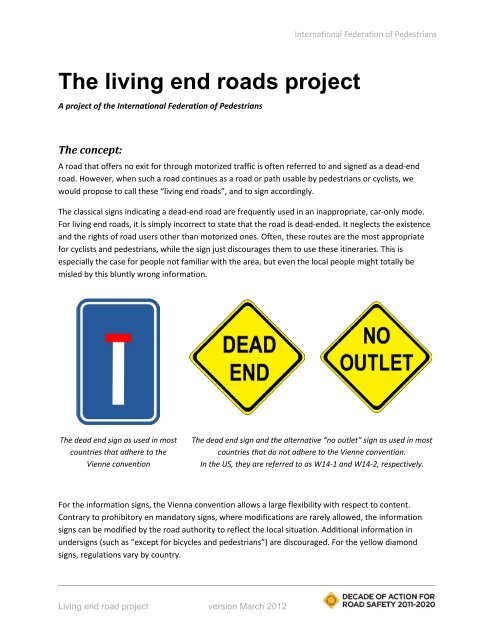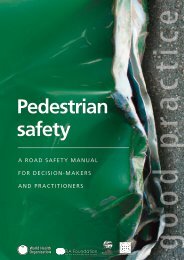The living end roads project - International Federation of Pedestrians
The living end roads project - International Federation of Pedestrians
The living end roads project - International Federation of Pedestrians
- No tags were found...
You also want an ePaper? Increase the reach of your titles
YUMPU automatically turns print PDFs into web optimized ePapers that Google loves.
<strong>International</strong> <strong>Federation</strong> <strong>of</strong> <strong>Pedestrians</strong><br />
<strong>The</strong> <strong>living</strong> <strong>end</strong> <strong>roads</strong> <strong>project</strong><br />
A <strong>project</strong> <strong>of</strong> the <strong>International</strong> <strong>Federation</strong> <strong>of</strong> <strong>Pedestrians</strong><br />
<strong>The</strong> concept:<br />
A road that <strong>of</strong>fers no exit for through motorized traffic is <strong>of</strong>ten referred to and signed as a dead-<strong>end</strong><br />
road. However, when such a road continues as a road or path usable by pedestrians or cyclists, we<br />
would propose to call these “<strong>living</strong> <strong>end</strong> <strong>roads</strong>”, and to sign accordingly.<br />
<strong>The</strong> classical signs indicating a dead-<strong>end</strong> road are frequently used in an inappropriate, car-only mode.<br />
For <strong>living</strong> <strong>end</strong> <strong>roads</strong>, it is simply incorrect to state that the road is dead-<strong>end</strong>ed. It neglects the existence<br />
and the rights <strong>of</strong> road users other than motorized ones. Often, these routes are the most appropriate<br />
for cyclists and pedestrians, while the sign just discourages them to use these itineraries. This is<br />
especially the case for people not familiar with the area, but even the local people might totally be<br />
misled by this bluntly wrong information.<br />
<strong>The</strong> dead <strong>end</strong> sign as used in most<br />
countries that adhere to the<br />
Vienne convention<br />
<strong>The</strong> dead <strong>end</strong> sign and the alternative “no outlet” sign as used in most<br />
countries that do not adhere to the Vienne convention.<br />
In the US, they are referred to as W14-1 and W14-2, respectively.<br />
For the information signs, the Vienna convention allows a large flexibility with respect to content.<br />
Contrary to prohibitory en mandatory signs, where modifications are rarely allowed, the information<br />
signs can be modified by the road authority to reflect the local situation. Additional information in<br />
undersigns (such as “except for bicycles and pedestrians”) are discouraged. For the yellow diamond<br />
signs, regulations vary by country.<br />
Living <strong>end</strong> road <strong>project</strong> version March 2012
<strong>International</strong> <strong>Federation</strong> <strong>of</strong> <strong>Pedestrians</strong><br />
Even though some countries occasionally provide some information on the <strong>living</strong> <strong>end</strong> nature <strong>of</strong> a road, they<br />
are used rather rarely. (<strong>The</strong> above signs are gathered in Belgium, Germany, Sweden, the Netherlands and<br />
Denmark, respectively),<br />
<strong>The</strong> improvement <strong>of</strong> the signage<br />
<strong>The</strong> <strong>International</strong> <strong>Federation</strong> <strong>of</strong> <strong>Pedestrians</strong> (IFP) prefers not to change the basic lay-out, but only to<br />
provide additional information in a non-cluttering way. <strong>The</strong> approach would be that the perception <strong>of</strong><br />
the sign from a distance (important for motorists) would be very similar to the basic dead-<strong>end</strong> street<br />
sign, while closer observers (cyclists and pedestrians) would be informed about their possibilities.<br />
Fussverkehr Schweiz, the Swiss Pedestrian Organization, studied 1 alternative signage, evaluating both<br />
undersigns and pictograms on the original sign. Road user preferences and readability <strong>of</strong> different<br />
alternatives were tested for the Vienna conference type <strong>of</strong> signs. <strong>The</strong> below signage was clearly<br />
preferred, and 84% <strong>of</strong> the respondents rated the additional information as “important” or “meaningful”.<br />
Living-<strong>end</strong> road (pedestrians)<br />
Living-<strong>end</strong> road (pedestrians and<br />
cyclists).<br />
Dead <strong>end</strong> for all<br />
1 In cooperation with ATSTRA, the Swiss Road Authority, and within the frame <strong>of</strong> an EU Interreg <strong>project</strong> ”SPATIAL<br />
METRO“ A Network for Discovery on Foot<br />
Living <strong>end</strong> road <strong>project</strong> version March 2012
<strong>International</strong> <strong>Federation</strong> <strong>of</strong> <strong>Pedestrians</strong><br />
For the non-Vienna-convention signs, a similar signage could be developed. Although those signs t<strong>end</strong> to<br />
be more text-based than icon-based, initial usability testing revealed positive acceptance and<br />
understanding <strong>of</strong> the proposed combinations <strong>of</strong> text and icons.<br />
Living-<strong>end</strong> road (pedestrians)<br />
Living-<strong>end</strong> road (pedestrians and<br />
cyclists).<br />
Dead <strong>end</strong> for all<br />
Possibilities for the local road authority<br />
<strong>The</strong> <strong>living</strong> <strong>end</strong> road <strong>project</strong> is ideally suited for the local road authorities, <strong>of</strong>ten the municipalities, since<br />
knowledge <strong>of</strong> the field resides with them, including the right <strong>of</strong> ways, footpaths and cycle tracks. With a<br />
relatively small effort, results that are valuable and visible can be generated. <strong>The</strong> <strong>living</strong> <strong>end</strong> road <strong>project</strong><br />
wants to stimulate the local road authorities to look at their inventory <strong>of</strong> “dead <strong>end</strong> road” signs and<br />
assess which <strong>of</strong> those in fact are <strong>living</strong> <strong>end</strong> <strong>roads</strong>.<br />
Implementation <strong>of</strong> the <strong>project</strong> simply entails to make an inventory <strong>of</strong> the existing dead-<strong>end</strong> signs in the<br />
area, to determine which <strong>of</strong> those require adaptation to <strong>living</strong> <strong>end</strong> signs, followed by making the change,<br />
and documenting it. Dep<strong>end</strong>ing on local circumstances, adapting the signs could be done by applying<br />
heavy-duty stickers or might need placing new signs. Where feasible, stickers with the additional<br />
pictogram that could be placed on the existing signs could be made available to the local road authority<br />
by the IFP through the local member organization.<br />
Living <strong>end</strong> road <strong>project</strong> version March 2012
<strong>International</strong> <strong>Federation</strong> <strong>of</strong> <strong>Pedestrians</strong><br />
Visibility is an important aspect <strong>of</strong> any <strong>project</strong>. A website gathering information on where <strong>living</strong> <strong>end</strong> road<br />
signs have been placed, combined with some additional statistics per municipality, is under<br />
development.<br />
Value <strong>of</strong> the <strong>project</strong><br />
<strong>The</strong> goal <strong>of</strong> the <strong>project</strong> is more than to have the relevant information available to the cyclist or<br />
pedestrian passing by. <strong>The</strong> “collateral” effects might be as important. Municipalities and people in the<br />
administration will have spent some time thinking about the road network from a sustainable road user<br />
point <strong>of</strong> view. Through this low-threshold <strong>project</strong>, they might become more sensitized and motivated to<br />
take pedestrians (and cyclists) rights and issues more into account in their daily work. And the road user<br />
might discover new routes, and maybe even decide to explore them leaving his/her car behind.<br />
Living <strong>end</strong> road <strong>project</strong> version March 2012






